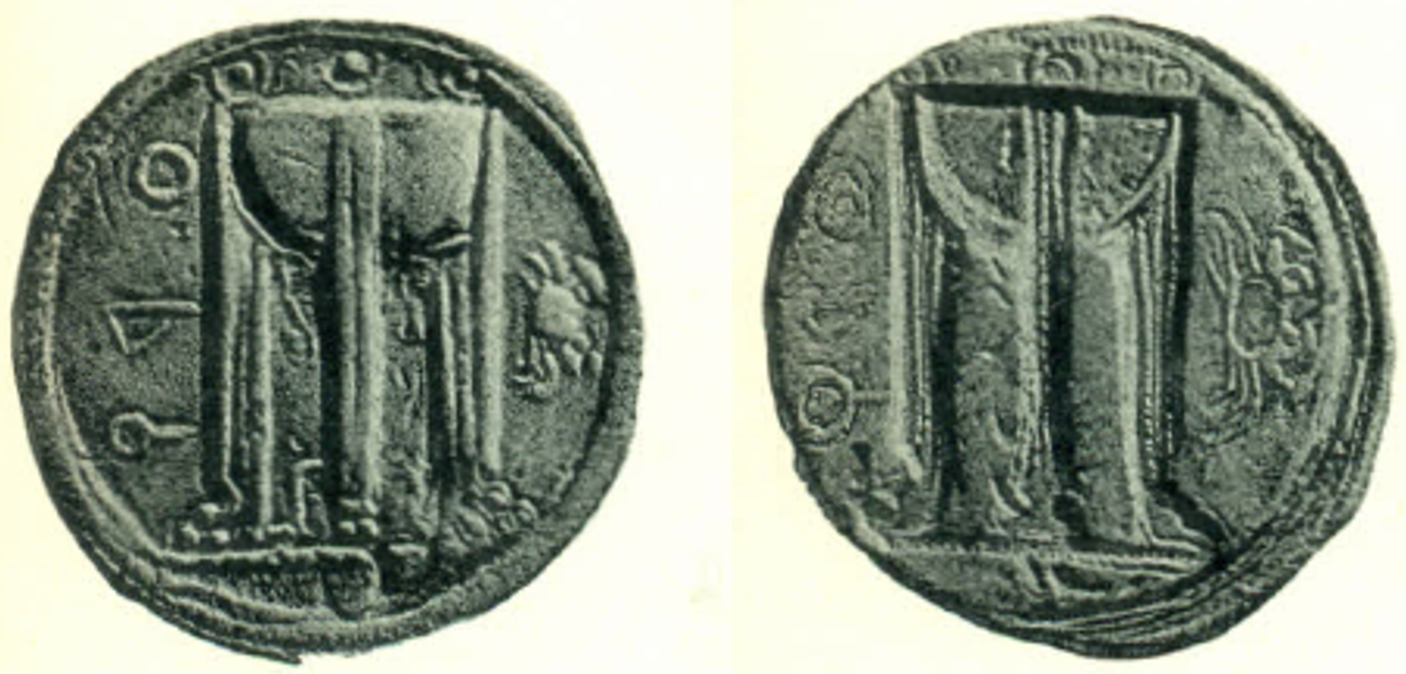2139 - Croton (nomos tripod/incuse tripod) over Metapontum (grain ear/incuse grain ear) (New York, ANS)
From SILVER
| Line 1: | Line 1: | ||
{{Overstrike | {{Overstrike | ||
|Image overstriking coin=SO 1277 - Croton over Metapontum.png | |Image overstriking coin=SO 1277 - Croton over Metapontum.png | ||
| + | |Image overstruck variety=Metapontum 520 BCE.jpeg | ||
| + | |Image reference overstruck variety=https://pro.coinarchives.com/a/lotviewer.php?LotID=2201722&AucID=5301&Lot=1121 | ||
|Museum collection=New York, American Numismatic Society | |Museum collection=New York, American Numismatic Society | ||
|Obverse legend=ϘPO | |Obverse legend=ϘPO | ||
Revision as of 17:06, 15 June 2023
530 BCE - 480 BCEϘPO | ϘPO
Images
Overstruck variety

Metapontum 520 BCE.jpeg [1]
Location/history
| Museum collectionMuseum collection: | New York, American Numismatic Society | |
Overstriking coin
Description
| ObverseInscription or printing placed on the obverse.: | ϘPO (Greek) Tripod. In right field, crab. | ReverseInscription or printing placed on the reverse.: | ϘPO (Greek) Tripod. In right field, crab (incuse). |
Mint and issuing power
| MintIdentifies the place of manufacture or issue of a numismatic object.: | Croton | Ancient regionAncient region. | Magna Graecia (Bruttium) | Modern countryModern country: Italy | AuthorityIdentifies the issuing power. The authority can be "pretended" when the name or the portrait of X is on the coin but he/she was not the issuing power. It can also be "uncertain" when there is no mention of X on the coin but he/she was the issuing power according to the historical sources: |
Chronology
| FromIdentifies the initial date in a range assigned in a numismatic context. 530 BCE toIdentifies the final date in a range assigned in a numismatic context.. 480 BCE | Archaic until 480 BC |
Physical description
| MetalThe physical material (usually metal) from which an object is made.: Silver |
WeightWeight of the numismatic object (in grams). in grams: 7.667.66 g <br />7,660 mg <br /> | DenominationTerm indicating the value of a numismatic object. Examples: tetradrachm, chalkous, denarius.: stater (Rutter), tridrachm/nomos (Hoover) | |
| StandardStandard.: Achaian (Hoover) | |||
References
| Coin referenceReference of the Coin: | Noe 1957, p. 13-42, pl. V-XIV (group I, p. 19, pl. V, d)., H. Miller | Coin series referenceReference to coin series study: | HN Italy1HN Italy, n° 2075-2083, 2085-2094, HGC 12HGC 1, n° 1446 |
| Coin series web referenceCoin series web references: | |||
Overstruck type
Description
| ObverseInscription or printing placed on the obverse.: | ReverseInscription or printing placed on the reverse.: |
Mint and issuing power
| MintIdentifies the place of manufacture or issue of a numismatic object. ᵖ: | Metapontum | Ancient regionAncient region. ᵖ | Magna Graecia (Lucania) | Modern countryModern country: Italy | AuthorityIdentifies the authority in whose name (explicitly or implicitly) a numismatic object was issued. ᵖ: |
Chronology
| FromIdentifies the initial date in a range assigned in a numismatic context. 515 BCE toIdentifies the final date in a range assigned in a numismatic context.. | periodTime period of the numismatic object. |
Physical description
References
| Coin type referenceReference to coin series study ᵖ: | Metapontum 139?3Metapontum 139? |
Additional data
| Frequency of overstrikesFrequency of overstrikes: | Level of confidenceLevel of confidence of the identification: | ||
| RemarksRemarks: | |||
References
- ^ Rutter N. Keith et alii (eds.) (2001), Historia Numorum Italy, London, xvi, 223 p., 43 pl.
- ^ Hoover, Oliver D. (2018), The Handbook of Greek Coinage Series, Volume 1. Handbook of Coins of Italy and Magna Graecia, Sixth to First Centuries BC., Lancaster-London, 2018, lxi, 527 pages, 23 cm
- ^ Metapontum 139?
